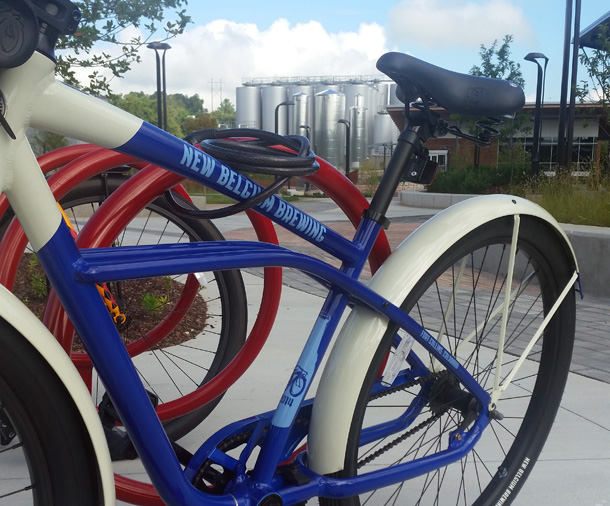
Seven years after New Belgium began selling beer in North Carolina it opened a second brewery in Asheville.
On March 2, 2009, New Belgium Brewing began selling beer in North Carolina. As the company has since 2006, when it began selling beer west of the Mississippi and started in Illinois, it offered three brands in 22-ounce bottles — Fat Tire Amber Ale, 1554 Black Lager and Mothership Wit. Two weeks later they launched the same three brands on draft, following with six-packs about a month later.
We were in North Carolina at the time and visited a package store March 3. Neat stacks of 1554 and Mothership Wit remained piled as high as an elephant’s eye. The Fat Tire was gone.
That’s how a flagship beer leads a brewery into a new market.
I did not include this anecdote when I wrote about Fat Tire today in my contribution to Flagship February. Perhaps I should have, but there were other words to be written. In 2009, Fat Tire accounted for 70 percent of New Belgium sales and it fueled expansion. Many customers thought Fat Tire was the name of the brewery, and the Fort Collins, Colorado, post office regularly delivered mail addressed to Fat Tire Brewery. It still does.
The popularity of Fat Tire was compared to that of Coors, which achieved cult status in the mid 1970s when it wasn’t sold east of the Mississippi. A New York Times story suggested, “it is not so much the product as the mystique surrounding it that is fascinating. It seems to have won a reputation as the elixir of beers, the brew of Presidents, a prize to be smuggled into the East the way Americans abroad used to smuggle in contraband copies of Henry Miller’s novels. Paul Newman, the king of beer drinking actors, is said to require Coors on ice at all his movie sets. Henry Kissinger regularly brought cases back to Washington each time he made a trip to California. Secret Service agents were forbidden to bring extra crates aboard Federal planes after one agent was discovered to have loaded 38 cases onto a recent flight from the West Coast.”
Bootleggers from New Jersey to Tennessee regularly sold cases of Coors for as much as $15, about three times the Colorado retail price, the Times reported. “I frankly can’t explain it,” Ernest Pyler, editor of Brewers Digest, told the paper. “Coors by brewing standards is a good beer, but so are many others. I think it’s mostly because of its unavailability.”
OK, that was part of it. But Coors also provided, and still provides, a flavor drinkers like. Fat Tire does as well. Even though off-premise sales shrunk in 2018, if Fat Tire were a brewery unto itself it would be among the 20 largest in the country. What happens next? “How We’ll Forget John Lennon” isn’t about about beer or brands, but it makes it obvious why it is important for brands to continue to be part of The Conversation.
Almost 16 years ago during the Craft Brewers Conference, New Belgium co-founder Kim Jordan delivered a challenge to Brewers Association members to triple market share (3.4 percent at the time). They did, easily. Setting a goal, in 2014, of reaching 20 percent in 2020 didn’t go as well. Share sits at about 13 percent right now.
Jordan called on brewers to work together. “To put it simply, to succeed as an industry, we must work very hard to be both enduring and endearing,” she said. They same could be said for individual breweries and brands.
When Stephen Beaumont and Jay Brooks invited me to contribute a post to Flagship February, I chose Fat Tire because of something Peter Bouckaert said in the summer of 2000. I’m old. I remember things today’s beer drinkers may never learn, and, quite honestly, things that may not really matter any more. I understand what Jeff Alworth means when he writes, “The concept of a flagship in almost all ways maps to an earlier and obsolete way of thinking. As long as customers remain focused on novelty and change, breweries will de-emphasize flagships. Even among those 80s and 90s-era breweries with inescapable ‘flagships,’ those beers will rarely be able to hold their volume and carry a brewery. Like everyone else, breweries of that era are constantly releasing new beers that can replace the flagship’s decline volumes.”
The #FlagshipFebruary hashtag provides proof. Nonetheless, plenty of the thousands of breweries that opened in the last dozen years rely on one beer for half their sales, making it over and over — the sort of iterations that ultimately lead to better beer across all brands.
No, they won’t account for three quarters of the beers the brewery sells, like Allagash White, across a good chunk of the country. They are the beers you will remember drinking when your daughter graduated college, when you finished paying off the loan on your first car, or any time Duke lost a basketball game.
Enduring moments call for enduring beers.
The problem is where to start in the chronology. Most of these age-d ales are actually clones of older classics so I tend to think more fondly of their antecedents. We have forgotten their eldest completely in many cases, just as we’ve been forgetting the beers that are being proposed as flagships now. I can’t imagine pulling out something as unspecial as a brewer’s bulk brand for a special day. But I tend to not associate special days with alcohol brands… or even alcohol fir that matter. What I do tie them to is incidental experiences – a great day at a ballpark, a chance meeting with an old pal. Safe, reliable and tasty.. The 3 pm July Saturday recovery beer, sitting in the shade or shed after a day of gardening. I’ll take that everytime.